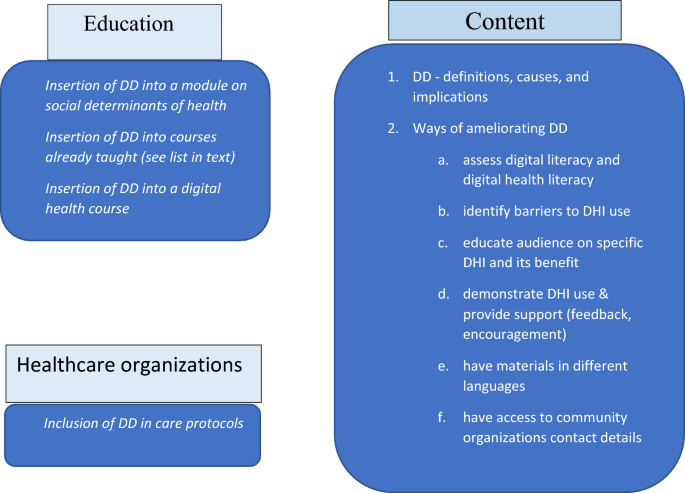
Towards bridging the digital divide: training healthcare professionals for digitally inclusive healthcare systems | Global Health Research and Policy
A necessary first step is to assess and compare existing HCP training curricula on DHIs and associated inequalities. Once this understanding is developed, we recommend devising comprehensive training and professional guidelines to aid HCPs in assessing their patients’ (and/or their caregivers’) access to DHIs in terms of digital literacy, access to suitable devices (e.g., smartphones or computers), internet connectivity, and motivation (see education and training recommendations in Fig. 1). We suggest that this should incorporate training to identify barriers patients may face in DHI access or adoption, and then develop strategies and means for patients to overcome these obstacles. Additionally, any solution must be culturally appropriate for the patient/caregiver; therefore, training must also focus on developing cultural competencies and sensitivities. The above addresses both the first and second digital divide.

Recommendations for the education and training of healthcare professionals on the digital divide (DD) and its amelioration
Recognizing the dynamic nature of DHIs, we propose that further research should focus on the needs of HCPs to keep their skills and knowledge updated and enable them to practice safely and effectively. This includes not only staying updated with emerging technologies but also developing competencies related to patient assessment and addressing barriers to DHI adoption. As the digital health divide is not limited to just patient groups, it should not be assumed that HCPs all have high-level knowledge and competencies for digital technologies in equal measure. Therefore, future research could explore the adequacy of existing courses and/or CPD, and develop new materials (e.g., online workshops, conferences).
Creating service-wide international standards for ameliorating the digital divide through HCP education and training can set an agenda and transform a vision into policies, which admittedly need to be continuously revised to accommodate technological changes as well as usher in competitiveness, responsiveness, and innovation (which are not the focus of the present position paper). The education and training of HCPs should be part of the global strategy to realize the potential of digital services in an accessible, scalable, and equitable manner [13] and benefit from global resolutions, strategies, commitment, policies (e.g., regulation) and investment of governments and organizations. Realizing the potential of digital services could mitigate the third digital divide (i.e., accrued benefits by geography, age, income and education, etc.) and advance the United Nations Sustainability Goal 10 (reduced inequalities).
Taking this path should be accompanied by a research agenda examining the engagement of citizens with DHIs by indicators of inequality, as well as efficacy and effectiveness of DHIs by these indicators of inequality [14]. As delineated above, König et al. pointed out that research itself inadvertently induces inequality through such practices as eligibility criteria, recruitment strategies or analytic decisions [4], and called for awareness by researchers and for research policies mandating inequality indicators into reporting guidelines and pre-registration templates [15]. Indeed, ensuring both researchers and HCPs acknowledge and work to address the digital divide when developing, evaluating, and applying DHIs will be paramount for a thriving, technologically-enhanced, healthcare landscape.

